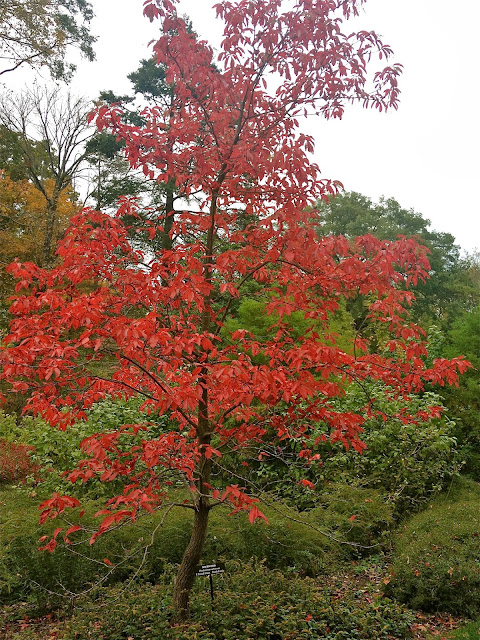As I keep hearing on the radio, temperatures in parts of the country are so cold right now that you can get frostbite if you're outside for more than a few minutes. Other parts of the country haven't had power for over a week due to crippling ice storms. So in comparison, my 35-degree day felt like the tropics and I decided to do what any gardener already sick of winter would do - do yard work. I tied up my Japanese holly so the next round of snow doesn't bend its branches. I also hacked away at the last remaining rose bush. I've barely made a dent in it but I only have so much room in my garbage pails. As I wandered around outside, I realized I never posted about my new additions to the allée so I thought I'd take the time now to both warm my fingers and mention the bushes I planted.
As I mentioned in my last post about the allée, my mother generously purchased some shrubs for me during my visit to New England in September. My criteria at the nursery was that the bushes wouldn't get too wide - there's just not enough room - and these shrubs were suggested, so we bought all three.
Nandina domestica
The first is one that I've been toying with buying for months. Nandina domestica, also known as Heavenly Bamboo, has gorgeous fall foliage and bright red berries in the winter. I thought I'd done my due diligence when I looked my state's invasive plant species list and did not find this specimen on that list (it exists on other state's invasive plant species lists). The one I purchased already had berries on them - berries that have since turned bright red. I've cut them all off and brought them inside to use as holiday decorations. And though I'm afraid of most birds (and therefore don't like most birds), the fact that the berries contain cyanide and are toxic to birds doesn't sit well with me at all. I'll need to consider this berry dilemma next year when they start to emerge again. It doesn't make sense to create a habitat of plants that bees and butterflies love and simultaneously poison birds.
Nandina domestica
 |
| Image courtesy of plant-care.com |
The first is one that I've been toying with buying for months. Nandina domestica, also known as Heavenly Bamboo, has gorgeous fall foliage and bright red berries in the winter. I thought I'd done my due diligence when I looked my state's invasive plant species list and did not find this specimen on that list (it exists on other state's invasive plant species lists). The one I purchased already had berries on them - berries that have since turned bright red. I've cut them all off and brought them inside to use as holiday decorations. And though I'm afraid of most birds (and therefore don't like most birds), the fact that the berries contain cyanide and are toxic to birds doesn't sit well with me at all. I'll need to consider this berry dilemma next year when they start to emerge again. It doesn't make sense to create a habitat of plants that bees and butterflies love and simultaneously poison birds.
Chamaecyparis obtusa 'Cross Compact' (Compact Fernleaf Cypress)
I love this plant. Love it. It looks like a tiny chartreuse Christmas tree at the moment. Its foliage looks like soft ferns. Online research is totally mixed. One site says it's rapid growing, the other says it's slow growing. One site says it's tighter and more compact and another site says it will branch out to 6-8 feet wide. The tag says it will look like an upright globe (what the what?). This is clearly a plant after my own heart as it sounds like it can't make up its mind and is in a constant state of identity crisis. It will also probably need to be moved as it's at the start of the pathway and it might get too big. It might be nice in front of or behind another bush (depending on which identity it assumes).
Those are the three new additions to my gardens. Unfortunately, I suffer from a bad case of one-itis, and these three singletons are joining a lone Golden St. Johns Wort, a single dwarf lilac, my pesky viburnum 'Summer Snowflake', and a random hydrangea. I may need to make some (or many) adjustments in the allée in the spring.























































